Hydrangea Fries Melba: all about growing a bush
In most cases hydrangea is a capricious plant. She needs daily watering, periodic feeding and pruning throughout the growing season. But not all species are demanding in care. A certain type of shrub has been bred - Fries Melba, which feels great in all weather conditions. The shrub has the best qualities inherent in a magnificently flowering beauty.
Content:
- Description and advantages of the variety
- Growing conditions
- Reproduction methods
- How to properly care for a plant?
- Pruning and preparing for winter
- Possible growing problems
- The use of hydrangea in the design of the site
Description and advantages of the variety
A French breeder was engaged in the cultivation of hydrangea Fries melba. After long work and attempts to grow an unpretentious shrub, he managed to present to society in 2014 a charming and not requiring excessive care beauty - the hydrangea Fries Melba. The shrub is a tall plant reaching 2 meters in height. But at the same time, the bush does not look wide or sloppy. It is compact due to the fact that hydrangea has poorly developed lateral branches. The main stem acts as a rigid support. Due to this, the blooming hydrangea bush does not require specific support during flowering.
The appearance of the first buds is recorded at the beginning of the second month of summer and continues until the arrival of the first subzero temperatures. In each region, the end of the formation of inflorescences is revealed in different ways. In addition, this type of hydrangea has good winter hardiness. Therefore, shrubs are not afraid of strong drops in temperature in Siberia and the Urals.
Hydrangea inflorescences are distinguished not only by erect stems, but also by the amazing size of the inflorescences. Small flowers are collected in one panicle, reaching 45-50 cm in length. The structure of the joints is dense, all the flowers sit close to each other. The panicle has a pointed shape.
Initially, when blooming, the inflorescences have a white tint, but over time, the buds gradually acquire a pink, and then a raspberry tone or red-wine color.
The foliage of the plant has an elongated, spiky shape. Leaves are smooth, glossy. They are attached to the main stem with small, reddish-brown petioles. The plant in most cases does not require abundant sunlight, so it can be planted in partial shade. Requires moist, drained soil when planting.
The advantages of hydrangea Fries Melba include the following points:
- It is immune to diseases and pests.
- Does not have increased requirements for the soil substrate.
- Due to the rather rigid structure of the stems, it does not need a specific support or garter.
- Lives well in the shade.
- Despite its size, it does not take up much space on the garden plot.
- Bush inflorescences are the highlight of every flower bed.
- Flowering continues for a long period of time.
- Does not require increased care of your accommodation.
- It is not afraid of severe frosts, therefore it has the ability to bloom in places with low temperatures.
The only requirement for long flowering is the pruning of the shrub. The procedure must be carried out during the period of laying flower buds, for abundant flowering, as well as as the buds bloom.
Growing conditions
In order to plant a plant so that it develops well and blooms gorgeous, it is recommended to choose a special place in which the Frize Melba hydrangea will feel great.
To do this, you should take into account some parameters for choosing a shrub:
- The shrub feels great both in a sunny open area and in semi-darkness. An ideal location would be a bright place, with a sufficient number of rays of the luminary, but at the same time it is recommended that during the midday sultry direct streams of light, the shrub is protected by a shade. Planting a plant should not be done in a place with a predominant shadow. It is recommended to root the seedling in an area where there is little sunlight.
- Soil with wetlands is categorically unsuitable. Although hydrangea prefers soil with high humidity, swampy soils only provoke decay root system... Also, very arid lands do not have the ability to qualitatively grow a full-fledged shrub with abundant flowering. Therefore, if planting is carried out in such an area, then it is worth adding the required amount of nutrient moisture daily. Otherwise, the plant will simply dry out.
- To prevent the bush from breaking under strong winds, it is recommended to choose a place near the fence or on the south side of the building. In addition, the plant can get sick on a penetrating constant draft. Therefore, it is recommended that before disembarking, it is better to examine all the marked places and choose the best site.
- Planting should be carried out in the spring, after the last spring frosts have gone. At this moment, the soil should warm up well by 10-15 cm, and a constant positive temperature will be established outside.
- The soil should be selected as a fertile, loamy soil substrate. The soil should have a slightly acidic pH environment. Soils with a large amount of contained limestone as well as sandstone should be avoided.
Reproduction methods
For reproduction, the following reproduction methods are used to obtain a second copy of the original:
- Cuttings - a reliable method for obtaining an original plant. In the spring, it is required to cut small shoots up to 12-15 cm in size. The planting material is taken from those branches cut during the formative pruning period. The resulting shoots are buried at an acute angle in nutritious moist soil, and covered with plastic wrap on top. This is necessary to reproduce the greenhouse conditions required for rapid germination. Cuttings in moist soil and elevated temperatures quickly form young roots and grow as an independent plant. Transplantation to a permanent place of residence in open ground is carried out the next year. In winter, the containers with the new plants obtained should be rearranged in a warm room.
- Getting a new plant can be done by rooting cuttings. The latter should be semi-lignified. Planting material should not be one year old or with fully lignified branches. The lowest branches of the bush are selected. The selected shoot is cut at the fold at the selected bud, almost to the middle of the shoot. A match is inserted into it so that it does not grow back together. Then the shoot is pinned to the ground using a hook or hairpins. A small lump of earth is poured onto the attachment site from above. The shoot should be watered periodically so that it quickly begins to form a root system and takes root on its own.The choice of the shoot and its dropping can be carried out at almost any moment of the vegetative period. But it is best to carry out the procedure in the spring. Over the summer, the shoot will fully take root and form a developed root system. The next year, in the spring, the young shrub can be completely detached from the mother shrub and transplanted to a new place of residence.
- To obtain a new seedling by dividing the rhizomes, the mother shrub, when it reaches 4-5 years of age, is dug out of the ground and carefully separated using a garden saw. The rhizome should be separated in such a way that on the resulting young bush there are several well-developed shoots. The cut is sprinkled with crushed activated carbon and planted in a new place of residence. This breeding method is extremely rare. It implies a mother liquor transplant, which is almost never done. Therefore, to obtain new seedlings, the propagation method is used either by layering or by cuttings.
How to properly care for a plant?
After planting a young seedling, care should be taken. It consists of the following positions:
- Loosening of the root area - the procedure is performed before watering. This is necessary to eliminate weeds that grow close to the root system and feed on nutrients necessary for the growth and development of the shrub. And also for the bush to obtain the necessary oxygen in the required volume and the rapid absorption of nutrient moisture during watering.
- Watering - should be carried out regularly as needed. It is not worth overfilling the plant, its root system reacts negatively to high humidity. When overflowing, decay of rhizomes or the development of pathogenic bacteria occurs.
- Mulching - carried out so that the soil under the bushes evaporates moisture as long as possible. This process has a beneficial effect on the hydrangea, preventing it from drying out. In addition, when using mulch, weeds cannot germinate from the soil. Mulching is carried out after the first application of feed water under the shrub. Wood bark or small dried sawdust is used as mulch, and crushed peat is also perfect.
- Top dressing - carried out in the spring, and then during the growing season 2 times a month. It is required to alternate mineral and organic fertilizers... It is imperative to fertilize with lime 1 time in 28 days.
Thus, excessive maintenance is not required for the development of the plant. The main thing is to carry out periodic watering and feeding. If you provide the plant with mulch, then for a long period it will get rid of the need to loosen the soil and clear the rapidly growing weeds.
Pruning and preparing for winter
Removal of excess branches for the Freise Melba shrub can be done both in the autumn after flowering, and in the spring before bud break. It is better to carry out the procedure in the spring.
To maintain the chic look of hydrangeas, the following types of pruning are carried out:
- Formative - essential for young seedlings. If the shrub has only 2-3 small sprouts, then they should be cut off without regret, so that the shoots from the branching are no more than 20-25 cm.It is necessary for the shrub to start branching more. Larger bushes should be cut to 1/3 of the total plant volume. In addition, all weak, non-viable and damaged branches are eliminated.
- Sanitary - carried out at the end of November, after the flowering of the plant. All shoots that have dried up during the summer period are eliminated, as well as those that have been mechanically damaged or affected by pathogenic bacteria or parasites. Removal of faded shoots is also performed. They are eliminated together with 2-3 lower kidneys.
- Thinning - pruning branches that thicken the internal structure of the bush. Such shoots grow inside the bush, provoking a beneficial environment for the formation of pathogenic bacteria and the colonization of parasites. You should carefully examine the internal location of the skeletal branches and guide them correctly, control the density by removing excess growth.
- Rejuvenating - if the hydrangea shrub becomes old, it is recommended to rejuvenate it. For the Freise Melba variety, no specific pruning has yet been developed, due to the fact that the plant was presented only 3 years ago and has not yet reached its old age. Therefore, the standard pruning procedure for an adult shrub is applied. For this, all old branches are removed, only strong and powerful young shoots are left. In order for the plant to develop faster, it is required to additionally eliminate all weak shoots.
In addition to pruning, the plant should be prepared for winter. In regions where the temperature regime does not fall below -30 C, for the successful wintering of the Frize Melba shrub, no additional shelter is required except for proper pruning.
In the event that the shrub is located in the northern regions of the country, although hydrangea has increased frost resistance, it is recommended to cover young seedlings with shoots and the root system. For this, a frame is constructed in a circle near the seedling, on which a covering material or film is put on top. After the snow mass has fallen out, a large snowdrift is superimposed on top of the base. In this form, the plant is perfectly preserved and does not freeze.
Possible growing problems
In most cases, the Frize Melba hydrangea does not respond to parasites or pathogenic bacteria. But in a number of situations, with improper placement or excessive watering, the plant can be subjected to the formation of the following diseases:
- Gray rot.
- White rot.
- Powdery mildew.
- Withering of a tracheomycotic character.
To eliminate the disease, you should use chemical fungicides and irrigate the shrub as the disease is acquired, preferably in the initial stages. Otherwise, the infection spreads over large areas and completely destroys the plant.
In case the leaves begin to dry out on the hydrangea and methodically fall off, you should check if there are parasitic insects in the middle of the bush. The following pests can settle on the plant and spoil the appearance:
If there are a small number of parasitic individuals, then they should be removed mechanically, by hand assembly. Otherwise, one should resort to folk methods of struggle or chemical irrigation of the bush. In order for the plant to grow large, chic and bloom profusely, it is recommended to monitor the external condition. If pathogenic bacteria or parasites are found, measures should be taken immediately, and not wait until the plant is completely covered with an ailment.
The use of hydrangea in the design of the site
Hydrangea looks advantageous in any form. It presents itself in an original manner surrounded by a riot of flowers, thanks to its erect shoots and considerable size. So it looks interesting when planting a plant among evergreens.
If the hydrangea was formed in such a way that the lower part stands out with a massive trunk, then it is recommended to plant lower varieties of plants in the foreground.
Thanks to this composition, an interesting look is obtained. Experienced gardeners are recommended to plant anemone next to the Fries Melba hydrangea to enhance the interesting effect. On a garden plot, the plant will look in any composition - both in a multi-level flower bed, and in the location between deciduous plants, as well as as an independent plant.
Thus, the young species of hydrangea Fries Melba is presented with an interesting appearance and bright huge inflorescences collected in panicles. The main thing is that its cultivation does not require constant painstaking care. It is important for high-quality growth to carry out proper care and control over the external state of the plant.
More information can be found in the video:



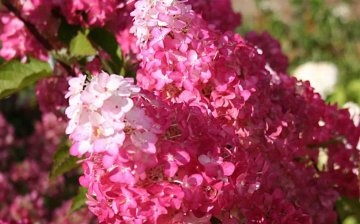
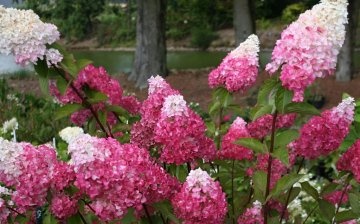
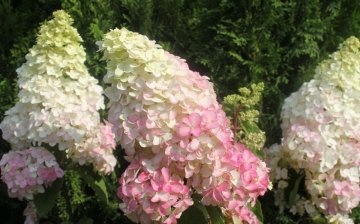
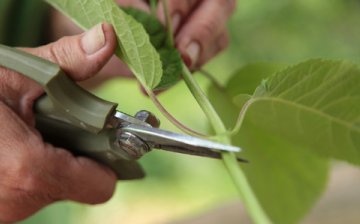
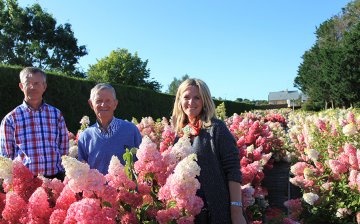

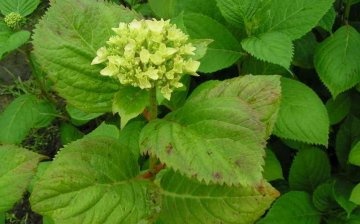
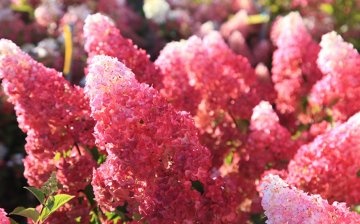








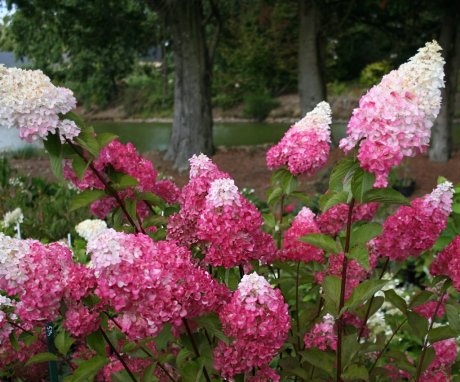
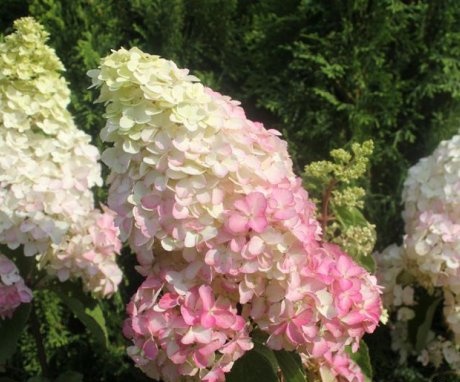

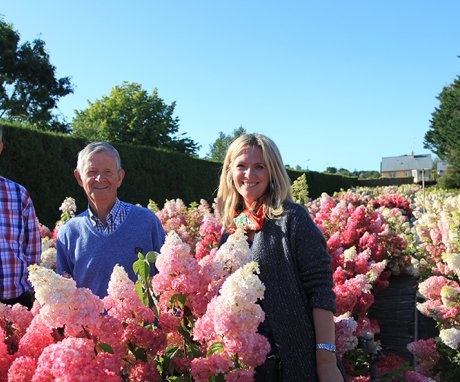
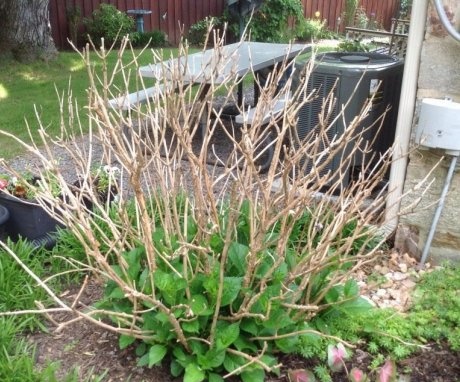

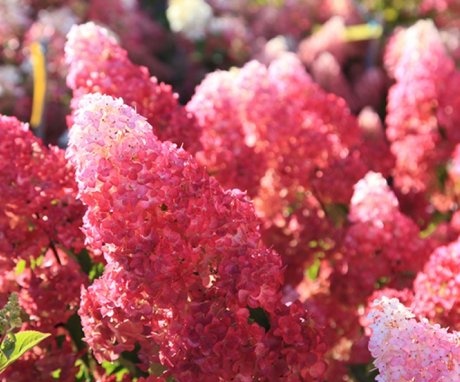
Hydrangea Fries Melba grows at a neighbor in the country house in the entrance group, shading with its beauty the bushes of nondescript (during the non-flowering period) lilacs. The neighbor thinks that it is beautiful. I think so too! Amazing beauty bush!